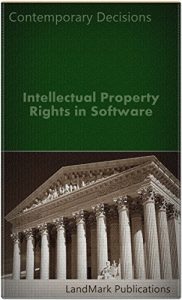THIS CASEBOOK contains a selection of 146 U. S. Court of Appeals decisions that analyze and discuss issues related to intellectual property rights in software applications. The selection of decisions spans from 2005 to the date of publication.
A party seeking to invalidate a patent on obviousness grounds must "demonstrate 'by clear and convincing evidence that a skilled artisan would have been motivated to combine the teachings of the prior art references to achieve the claimed invention, and that the skilled artisan would have had a reasonable expectation of success in doing so.'" Procter & Gamble Co. v. Teva Pharm. USA, Inc., 566 F.3d 989, 994 (Fed. Cir. 2009) (quoting Pfizer, Inc. v. Apotex, Inc., 480 F.3d 1348, 1361 (Fed. Cir. 2007)). While an analysis of any teaching, suggestion, or motivation to combine elements from different prior art references is useful in an obviousness analysis, the overall inquiry must be expansive and flexible. KSR Int'l Co. v. Teleflex, Inc., 550 U.S. 398, 415, 419 (2007). "Often, it will be necessary for a court to look to interrelated teachings of multiple patents; the effects of demands known to the design community or present in the marketplace; and the background knowledge possessed by a person having ordinary skill in the art, all in order to determine whether there was an apparent reason to combine the known elements in the fashion claimed by the patent at issue. To facilitate review, this analysis should be made explicit." Id. at 418 (citing In re Kahn, 441 F.3d 977, 988 (Fed. Cir. 2006) ("[R]ejections on obviousness grounds cannot be sustained by mere conclusory statements; instead, there must be some articulated reasoning with some rational underpinning to support the legal conclusion of obviousness.")). Intouch Technologies, Inc. v. VGO Communications, Inc., (Fed. Cir. 2014)
A party seeking to invalidate a patent on obviousness grounds must "demonstrate 'by clear and convincing evidence that a skilled artisan would have been motivated to combine the teachings of the prior art references to achieve the claimed invention, and that the skilled artisan would have had a reasonable expectation of success in doing so.'" Procter & Gamble Co. v. Teva Pharm. USA, Inc., 566 F.3d 989, 994 (Fed. Cir. 2009) (quoting Pfizer, Inc. v. Apotex, Inc., 480 F.3d 1348, 1361 (Fed. Cir. 2007)). While an analysis of any teaching, suggestion, or motivation to combine elements from different prior art references is useful in an obviousness analysis, the overall inquiry must be expansive and flexible. KSR Int'l Co. v. Teleflex, Inc., 550 U.S. 398, 415, 419 (2007). "Often, it will be necessary for a court to look to interrelated teachings of multiple patents; the effects of demands known to the design community or present in the marketplace; and the background knowledge possessed by a person having ordinary skill in the art, all in order to determine whether there was an apparent reason to combine the known elements in the fashion claimed by the patent at issue. To facilitate review, this analysis should be made explicit." Id. at 418 (citing In re Kahn, 441 F.3d 977, 988 (Fed. Cir. 2006) ("[R]ejections on obviousness grounds cannot be sustained by mere conclusory statements; instead, there must be some articulated reasoning with some rational underpinning to support the legal conclusion of obviousness.")). Intouch Technologies, Inc. v. VGO Communications, Inc., (Fed. Cir. 2014)



